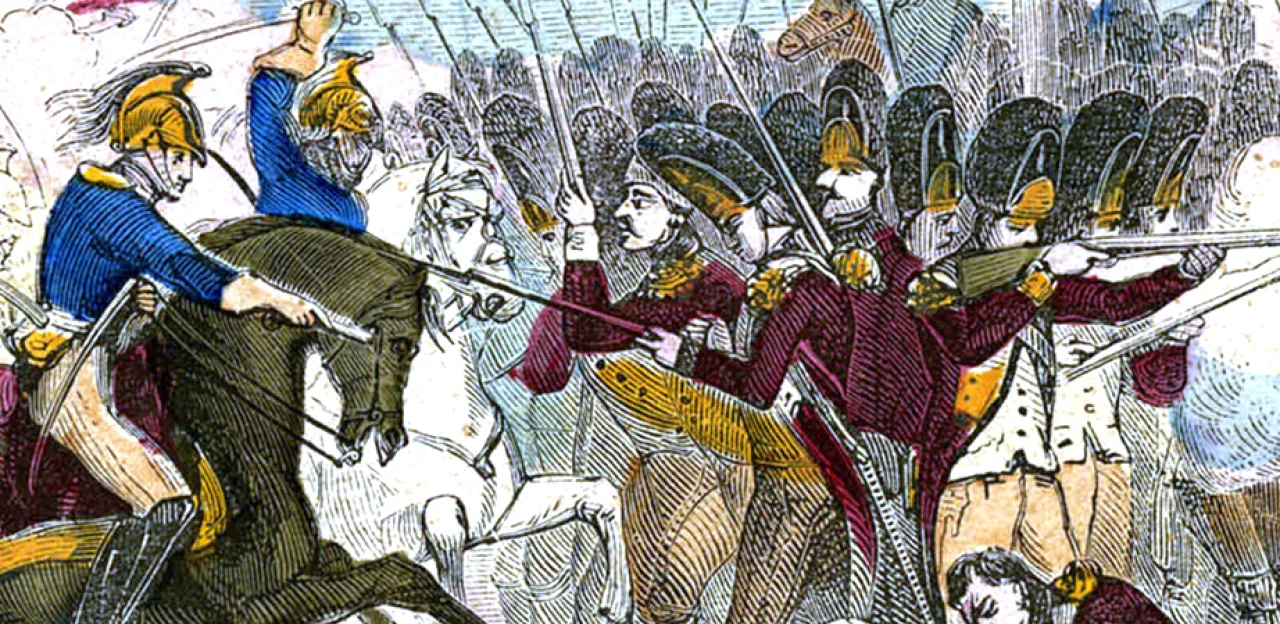The Battle of Hanging Rock

Enraged by the ruthless Waxhaws Massacre on May 29, 1780, and fueled by anger after the British burned his home, General Thomas Sumter and his militia embarked on a guerrilla campaign in South Carolina. The ensuing battles in the colony would transform South Carolina into the site of the first American civil war, pitting brother against brother.
Following the May 1780 Fall of Charleston, the British established a numerous outposts in South Carolina with the intention of restoring Royal authority over the colony's population and resources. General Sumter's plan in his guerrilla campaign was to target these outposts with small calculated attacks, confident that the British would be unable to quickly assemble substantial troops to adequately defend any one outpost. Ultimately, Sumter hoped to convince the British that remaining at key strategic locations along the Santee and Wateree Rivers was undesirable and unsustainable.
On July 17, 1780, Sumter wrote to General Johann de Kalb from his camp on the Catawaba River expressing his desire to “prevent them [the British] from forcing the Militia to retreat…and also from stripping the country of all its resources.” He also gave de Kalb the best intelligence at his disposal: the British had 800 men in Charleston, 12 in Beaufort, 250 at Ninety Six, 200 at Rocky Mount, 700 at Camden, and 280 men on foot in addition to 70 dragoons occupied Hanging Rock. Another 1,100 British lurked in Georgia. In total, Sumter estimated that 3,482 British troops were within reasonable striking distance, which he called “most interesting.”
Situated on the road between Camden, considered the key to controlling the backcountry of the Carolinas, and Charlotte, the outpost at Hanging Rock provided the British with a significant amount of natural cover. Hanging Rock was a garrison divided among three separate encampments of the British and Loyalist partisans. The separation of the encampments would Hanging Rock would contribute to Sumter's success. The area on the east side of Hanging Rock Creek was heavily wooded with steep banks that led down to a creek full of massive boulders. The British camped on the west side of the creek where the ground rose sharply from the creak and plateaued. The rocks and trees surrounding Hanging Rock were also essential factors in the success of the Continental attacks.
On July 30, 1780, while Sumter staged an attack on the nearby Rocky Mount outpost west of Hanging Rock, Major William Richardson Davie and his North Carolina Independent Corps of Light Horse created a diversion. Davie and his men set out to ambush Colonel Samuel Bryan’s North Carolina Loyalist Militia at Hanging Rock. With 40 dragoons and roughly the same amount of mounted riflemen, Davie’s force was far too small to take on Bryan’s full force of 500. Instead, Davie focused his efforts on a separated garrisoned house near the fort at Hanging Rock.
Using the similarities in dress, speech, and manner between his men and Bryan’s Loyalists to their advantage, Davie’s mountain riflemen casually rode into three companies of Loyalist mounted infantry without raising suspicion before opening fire on the enemy. Anticipating the Loyalist attempt to flee, Davie circled his dragoons to cut off their retreat. Davie had boldly attacked in plain view of the main Loyalist encampment and, having routed a small number of Loyalists, Davie successfully withdrew before reinforcements arrived.
16 miles to the west, Sumter's attack at Rocky Mount had been thwarted by a thunderstorm, increasing Sumter's determination to strike a blow. On August 5, Sumter launched his own attack on Hanging Rock. Reinforced by Davie and nearly 800 troops, Sumter marched the 16 miles through the night, stopping just short of Hanging Rock. Crossing Hanging Rock Creek at 6:00 am, the attack began.
Unintimidated by the surprise attack, the British defenders under Major John Carden refused to retreat without a fight. Twice, the British fixed their bayonets and charged Sumter's men in an effort that Colonel Banastre Tarleton called “the example of courage.” The Continentals quickly took shelter behind rocks and trees, using the natural defenses as a cover while firing into the British lines. Within a few minutes, most of the British officers had been shot, and within a half hour, the Continentals overtook the British Camp.
Although Sumter achieved victory at that particular encampment, British soldiers and South Carolina Loyalists under Colonel Joseph Robinson’s still defended the main camp at Hanging Rock. Using captured British ammunition, Sumter moved to the main camp and forced the British into a southward retreat, and captured two-thirds of the camp.
The Battle of Hanging Rock raged on for a total of three hours in the sweltering South Carolina summer. Slowly, the Patriots overtook the majority of the British camp and began ransacking British stores and stealing supplies. Exhausted, many of Sumter’s men could no longer continue fighting. Watching Patriots plundering the camp, many of them having become inebriated on seized British rum, Sumter called off a continued attack. As Sumter's men, feeling victorious departed Hanging Rock, the British and Loyalists that remained at the camp perceived the departure as a retreat and felt their own victory in a way. While the British “consoled themselves with some military music and an interlude of Three Cheers for King George,” the Continentals sang “Three Cheers and the Hero of American Liberty.” At 1:00 pm, Sumter’s men safely retreated.
Each side believed that they were the victor – the British because they did not give up all of their ground and the Continentals because they captured significant amounts of British stores and were able to withdraw unmolested. In terms of casualties, the British suffered nearly 350 while the Patriots lost less than 100.
Join the American Battlefield Trust in preserving 218 acres of hallowed Revolutionary War ground and expanding The Liberty Trail before America’s...
Related Battles
53
200
12
20


